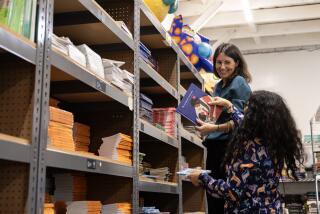TEMPLE-BEAUDRY : A Treasure-Trove of Philippine History
- Share via
When Helen Brown unlocks the narrow sliver of a room tucked inside the Filipino Christian Church she opens a door to Philippine history and nearly a century of family memories.
Brown is the founder and director of the Pilipino-American Reading Room and Library. The library is a repository of materials documenting the history, culture and politics of Filipinos in the Philippines and the United States. (Since Tagalog, the main Philippine dialect, has no F sound, some reject the traditional spelling of Filipino, preferring to use a P.)
Barely 15 feet long and about half as wide, the library contains shelves of books, journals, boxes of research papers and piles of scrapbooks that nearly reach the high ceiling. When the church offered the space “it was a mess, but we saw the possibility,” Brown said. “My husband and I and our four sons cleaned it up, painted it and built the shelves. We opened in 1986.”
But the history of the library, and Brown’s Philippine connection, goes back further.
In 1901, Brown’s father sailed to the Philippines aboard the USS Thomas as one of a contingent of teachers recruited by the U.S. government to spread American influence and English throughout the archipelagic nation.
Three years before, the United States and Spain had signed a treaty turning over control of the Philippines to the United States. Once the indigenous rebellion against American rule was crushed, the United States dug its heels in, beginning what is to this day “a love-hate relationship” with the Philippines, Brown said.
In 1910, Brown’s father married a Filipina, the daughter of a provincial governor. Five years later, Helen Agcaoili Summers Brown was born.
With the heavy American influence in her native land, Brown learned little about the Philippines while she lived there, she said.
“I didn’t learn to be Pilipino until I came to the United States,” said Brown, who left the islands for Los Angeles in 1933 and became the first Filipina to graduate from UCLA in 1937.
She inherited her father’s collection of materials on the Philippines and added to it as she reclaimed her identity, bolstered by the writings and work of activists like Carlos Bulosan and Philip Vera Cruz.
Brown went on to become an oft-honored teacher and social worker and a respected activist in Los Angeles’ Filipino community. She recently received a medal of honor from UCLA’s student body and will be honored for her work next month by the Leadership Education for Asian Pacifics Inc.
Brown’s library is “a very important source of Pilipino-American history,” said Joel Jacinto, executive director of Search to Involve Pilipino Americans. “She’s a tremendous resource for young people and a treasure for the community.”
Visitors include college students, teachers and administrators from the Los Angeles Unified School District who are developing a multicultural curriculum. Scholars from throughout the country call with questions and requests for information and the city’s Central Library will included some of Brown’s photos in its upcoming “Shades of L.A.” collection.
The library is at 301 N. Union St. and is open from 1 to 6 p.m., Tuesdays and Thursdays.
Information: (213) 484-0818.
More to Read
Sign up for Essential California
The most important California stories and recommendations in your inbox every morning.
You may occasionally receive promotional content from the Los Angeles Times.










